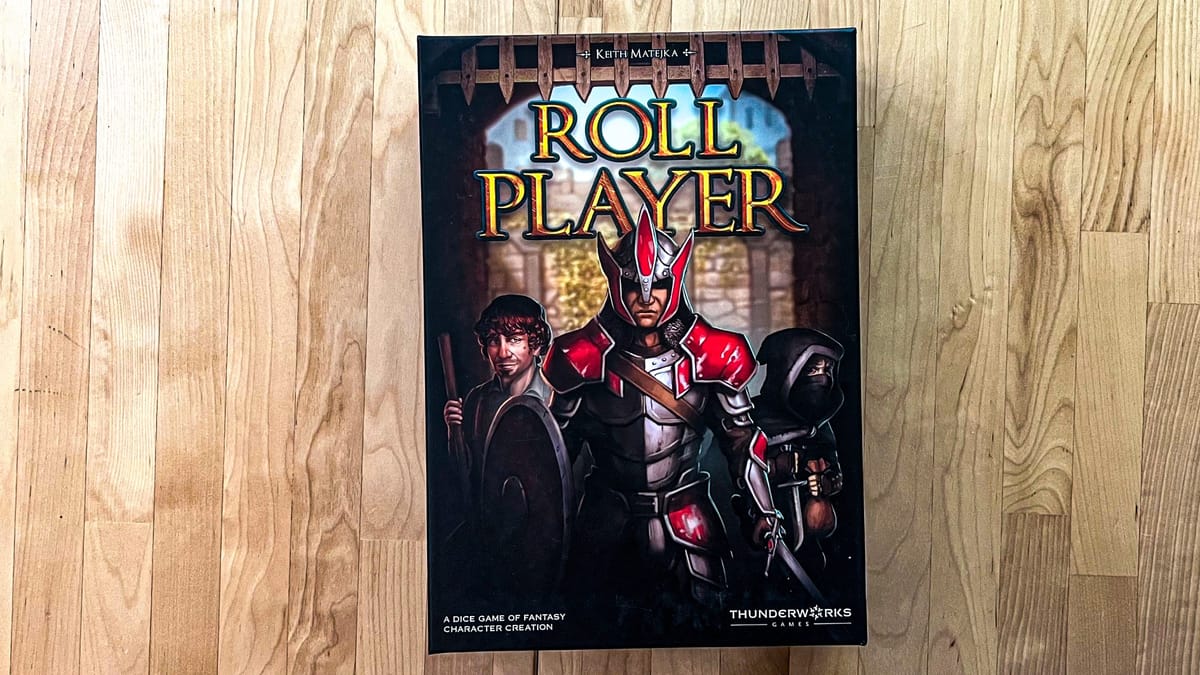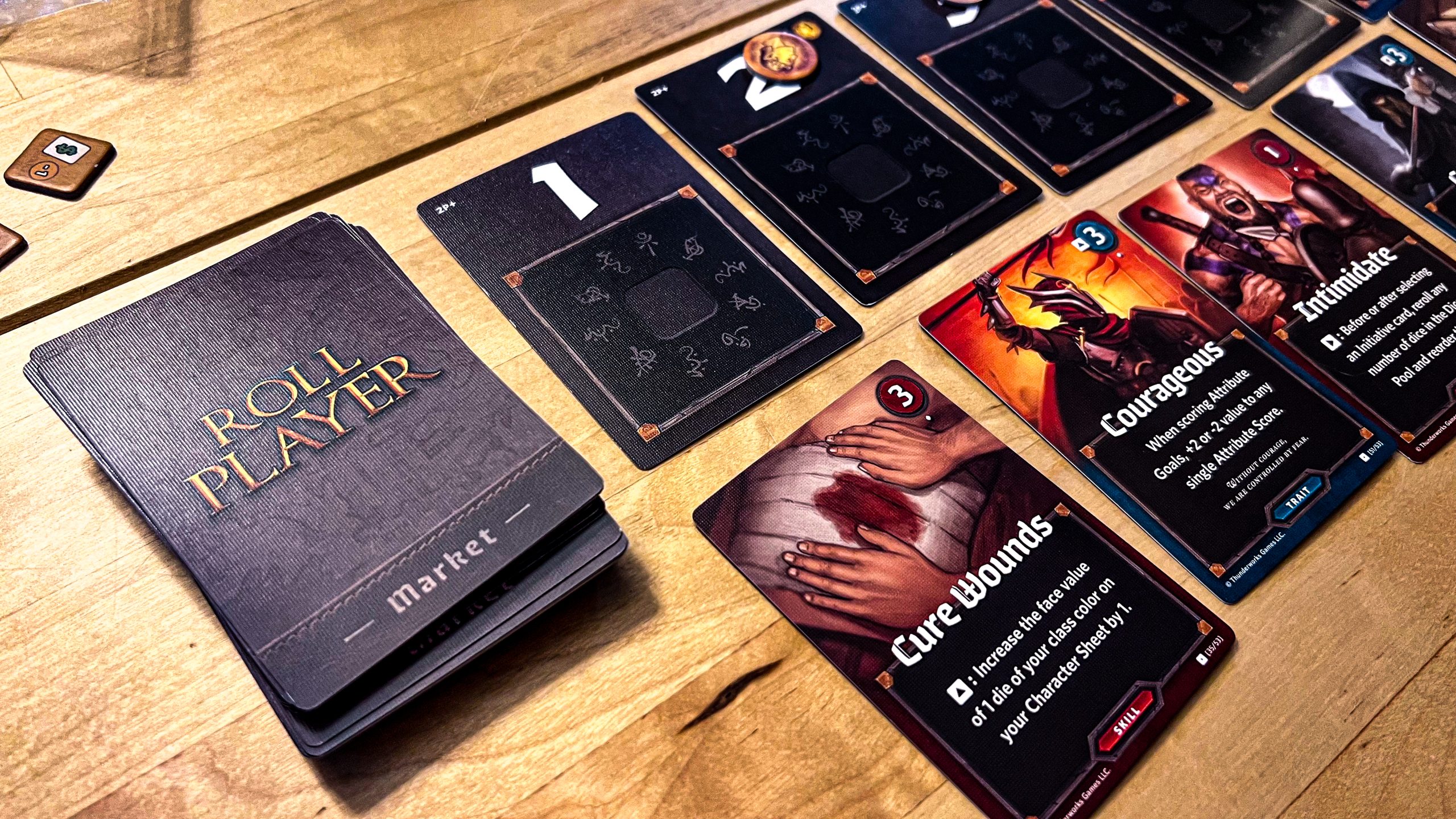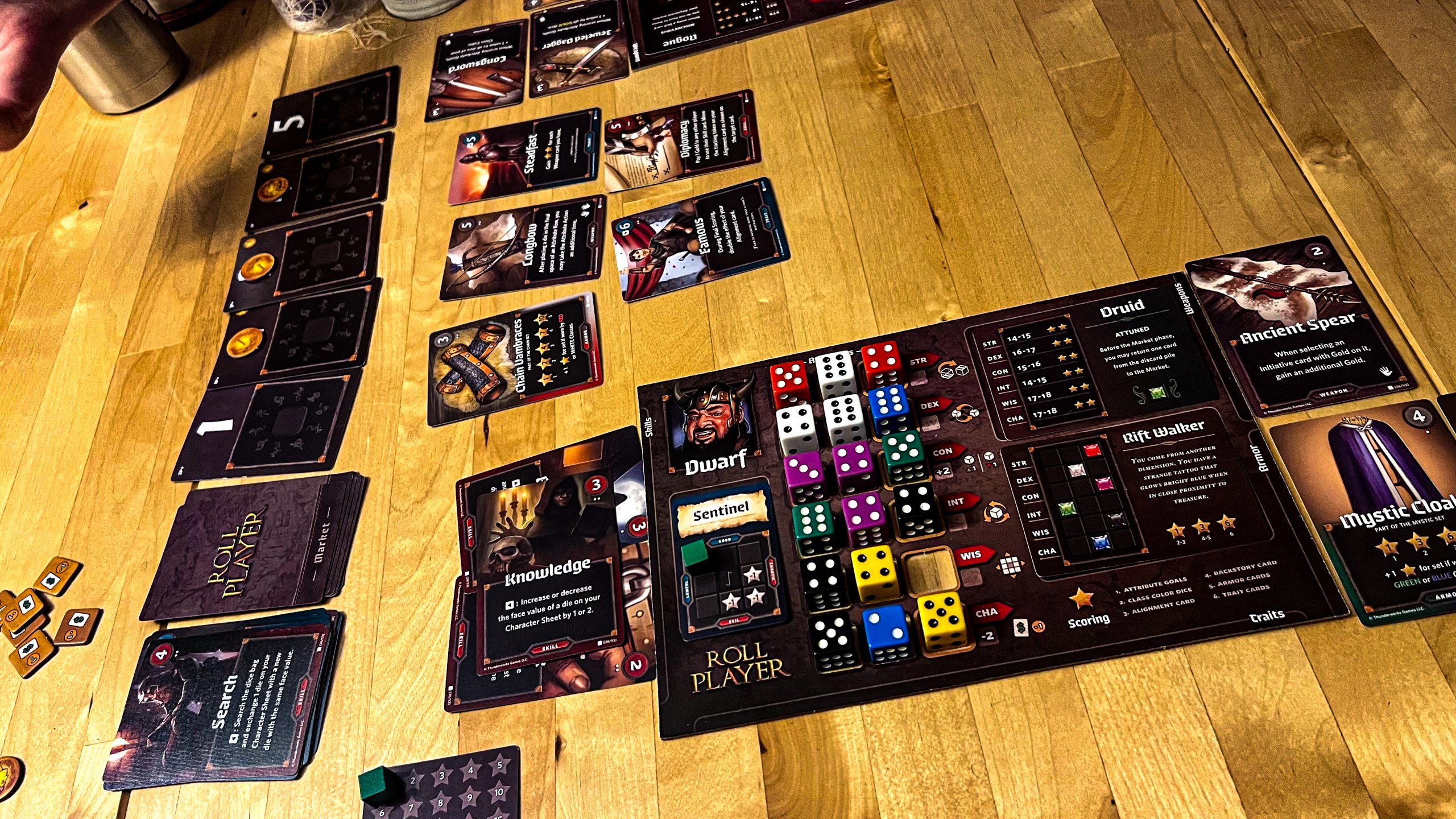
Powergaming, the act of optimizing a tabletop RPG character that maximizes benefits with little risk, is a controversial subject in the tabletop world. The phrase “min-maxer” comes to mind, along with deep discussions about exploits, bending the rules of the game, taking away opportunities from new players, and the ethics of such a technique. Powergamers have the ability to ruin the game for others, or create a wild amount of fun. As someone who personally loves building min-max pro wrestler builds, it’s a blast.
But what if Powergaming was the game itself? What if the goal was to try to build the biggest, beefiest, cheese character you could, with number busting skills, all of the armor, the strongest weapons, and high scores in every attribute on the character sheet?
That’s what Roll Player, a 2016 game from Thunderworks Games, designed by Keith Matejka, brings to the table. 1-4 players can set off on building the greatest fantasy adventurer that has ever lived, through dice manipulation, rolling, open drafting, and the collection of various sets of armor, skills, and traits, all of which serve the goal of gaining the most Reputation Stars.

The cards feature rich artwork in the sword and sorcery theme
Upon opening the box, the player is greeted with multiple character sheets which represent the various races in a Dungeons & Dragons-esque universe, along with 73 dice, 101 cards broken up into Player Aid, Class, Backstory, Alignment, Market, and Initiative cards, some gold tokens, tracking tokens, and finally Charisma tokens. The quality of all of these items is pretty top notch, though for the discerning board game owner, I would suggest some card sleeves, as you will be moving cards around alot.
The artwork & graphic direction by JJ Ariosa and Luis Francisco feels right at home in a sword & sorcery world, with beautifully detailed item cards, interesting skills & traits, and wonderful looking portraits on the character sheets.
There’s also a rulebook, which you will read several times, including during play. This is a game with multiple mechanics, and a lot of calculation. I noticed at my table, even the most seasoned D&D player had to ask for rule clarifications. This is a game where it’s pretty valuable to watch multiple playthroughs and walkthroughs on YouTube, and if you’re the game owner, try to be the one who knows the rules best, as you will be asked often about specifics in the phases & cards.
Game play is broken up into the Setup and the Game, which then has 4 phases. The setup allows the players to learn the system of the game, which involves drafting dice, and placing them into Attribute Rows on their character sheets. These rows correspond to the traditional attributes in a tabletop RPG, so it’s familiar. They also select a backstory, a class, and an alignment card. Classes are selected based on dice color pulled out of the bag, and everything else is random…this leads to a LOT of replayability. My table of 4 folx were very excited to play this multiple times over.

The game includes handy rule cards for quick reference
Once you start the game, it’s easy to pick up after a few rounds. In each round, a Start Player draws dice, rolls, and sets up the Initiative. Players then select which initiative card they want, collecting the dice, adding the dice to their character sheet, and taking advantage of special Attribute Actions, such as flipping a die to it’s opposite side, swapping dice in the sheet, changing their alignment. This is important because each player has unique goals that align to their class, backstory, and alignment, and it takes some planning and reacting to the dice drafting and market purchasing that is happening.
The second phase, the Market Phase, is another area of strategic depth. Players consider buying or trashing items another player may need. Does that dwarf paladin need those chain gloves to complete their set of armor, or do you take on a squire, which will give you another Reputation Star? We found ourselves spending a decent chunk of time in the Market Phase, plotting, discussing, even bribing each other (not a rule in the game, but house rules allow for bribes).
Then, a Clean Up phase sets up the next round. Rinse and repeat until all 18 slots on the Character Sheet are full, then it’s time to count up Final Scores. This part of the game was very easy, and we were thrilled by the end, definitely wanting to play again, but we had spent a good 90 minutes with our first experience with Roll Player.

The player’s goal is to fill the entire character sheet, maximizing every stat and gathering as many Reputation Stars as possible!
Reflecting on the whole experience, it’s a great game. It’s inventive because it dives so deeply into character creation, and makes it so much fun. it has me wanting more of that kind of mechanic in a TTRPG setting, but that’s just me. I do think some things detract from the experience of Roll Player, but they’re minor at most. For example, while the quality of the assets of the game are pretty high, storage ends up being just some plastic bags, so you will definitely be stuck reshuffling cards, separating elements, and the box doesn’t provide a way to hold all of these assets in place, so prepare yourself, and try to not let it fall over. Also, the rules are complex. Even after watching multiple videos and reading the rulebook several times, we still made some errors in gameplay, and there were questions that were not covered by the book, so we had to house rule them. That being said, gameplay wasn’t sacrificed, and everyone had a good time, and wanted to play again, which allows you to overlook these minor flaws.
Roll Player is widely available both online and at your FLGS, and as of this writing there are several expansions which greatly increase the depth and replayability of the game. Most notably, there’s an expansion called Monsters and Minions which adds a combat phase, challenging the heroes to battle against the Monster…I really want to try that out. If you have the opportunity, I recommend giving Roll Player a shot, especially with your RPG minded friends.
Roll Player
Great
Roll Player is a fun and complex game, which explores the minutiae of character creation. The complexity could be a turn off to some players, but if you spend the time understanding the system and rules, you will walk away with a generally rewarding experience.
Pros
- Great game mechanics involving dice rolling, drafting, and manipulation
- Incredibly unique concept, with a ton of replayability
Cons
- Complexity of the rules may confuse some players
- Wish there was better storage of the game pieces.
